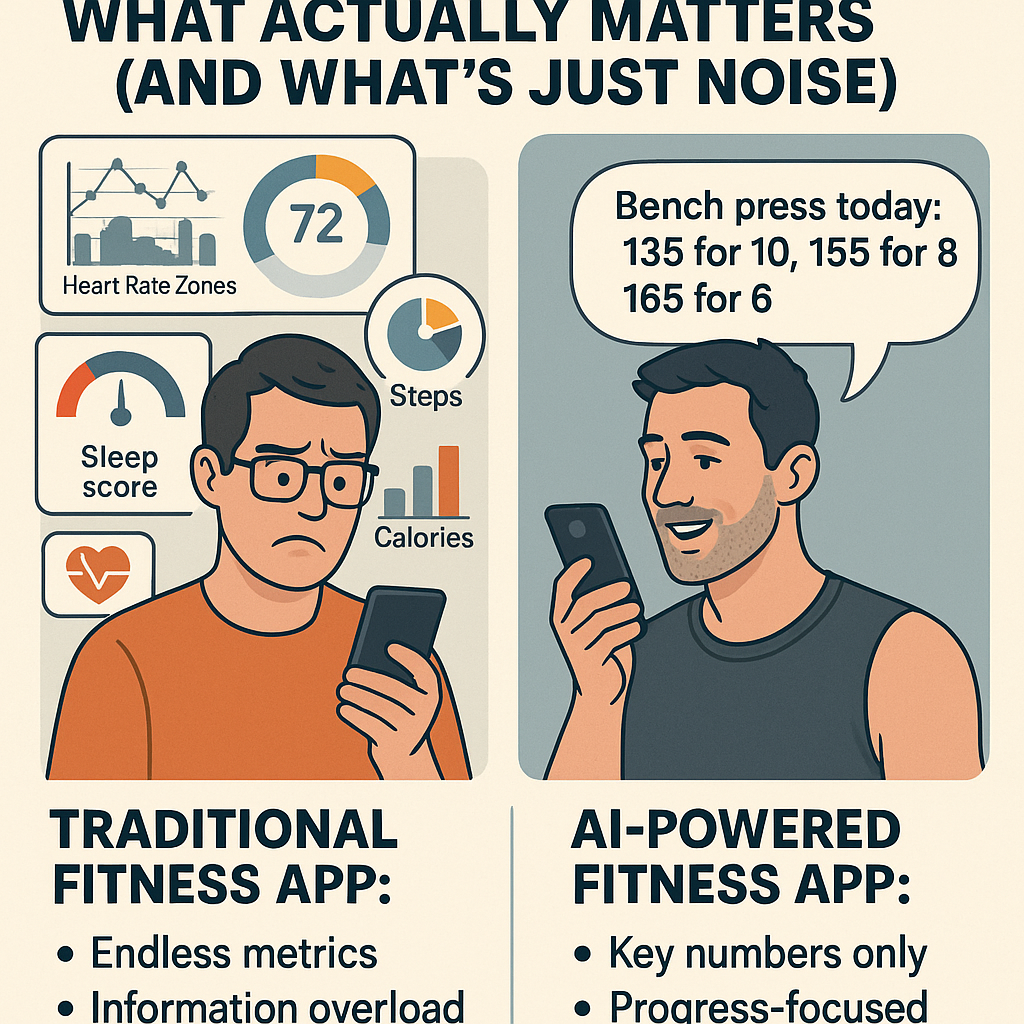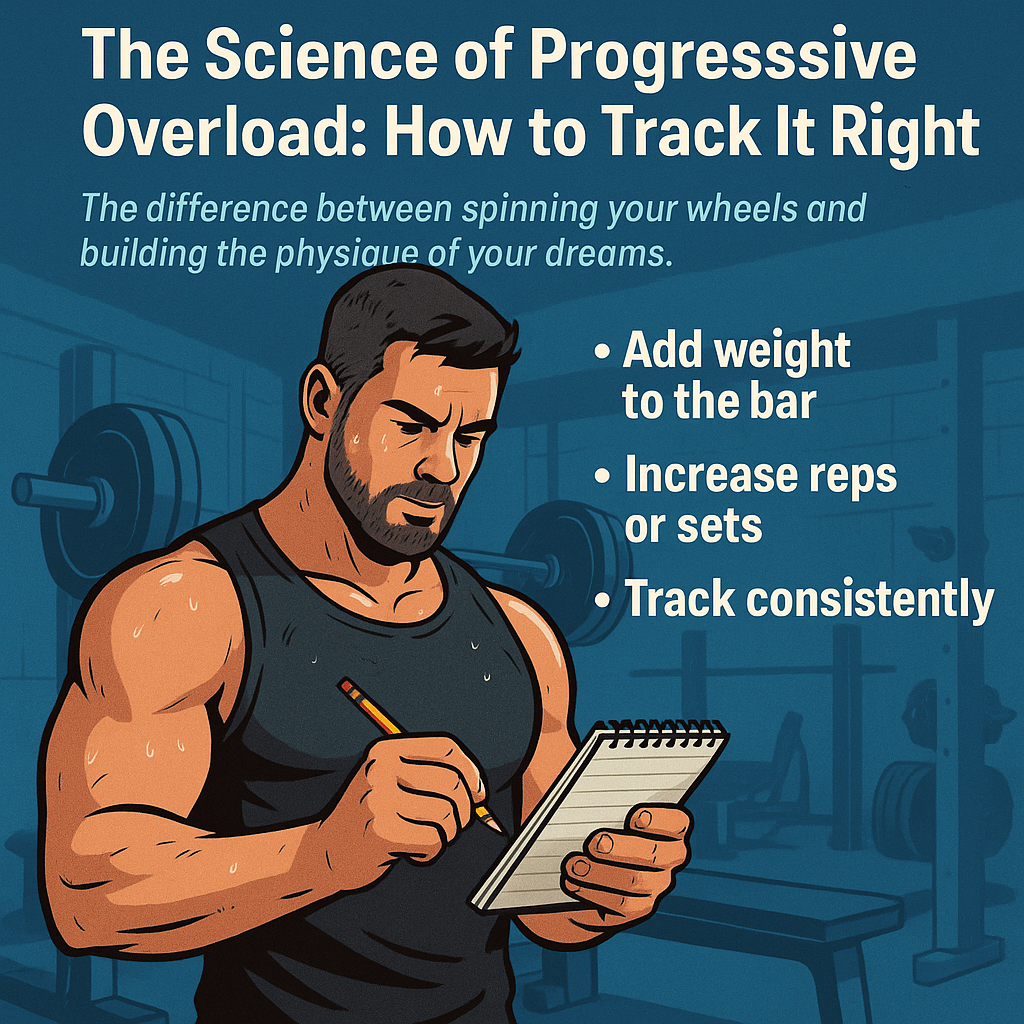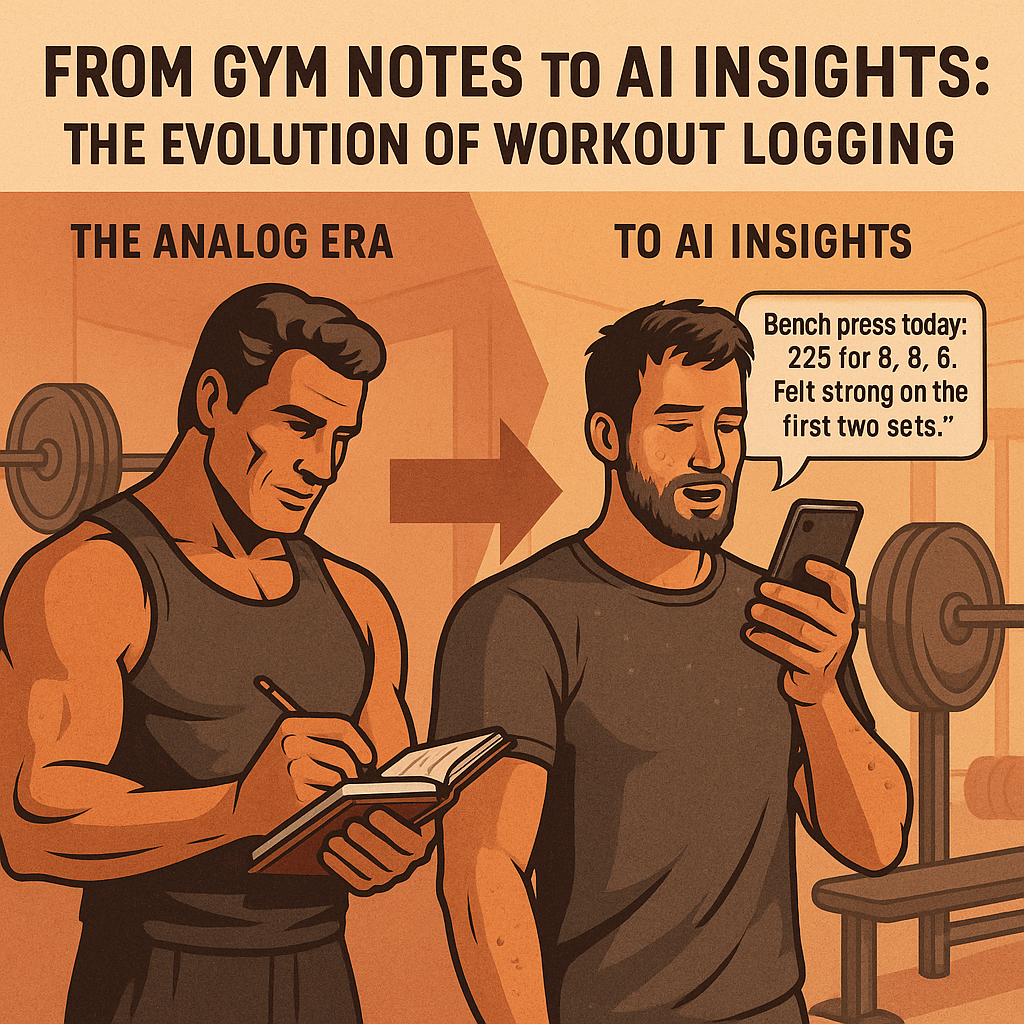The Real Guide to Workout Data: What Actually Matters (And What's Just Noise)
Ever feel like you're drowning in fitness numbers but still not getting stronger? Here's the truth about what to track and what to ignore.
You know that feeling when you open your fitness app and see 47 different charts, graphs, and numbers staring back at you?
Heart rate zones. Sleep scores. Step counts. Calorie estimates that change every time you sneeze. Recovery percentages based on... honestly, who knows what.
And after staring at all this data for 20 minutes, you ask yourself: "Am I actually getting stronger, or am I just becoming really good at collecting random numbers?"
Here's the thing that no fitness app wants to tell you: Most of that data is completely useless.
I'm going to show you the 4 simple numbers that actually matter for getting jacked. Plus, how modern AI (like W8Log) can track these automatically without turning you into a data entry clerk.
The Great Fitness Data Scam 📊
Let me paint you a picture of the modern gym-goer:
6:00 AM: Check sleep score (7.2/10 - panic because it's not 8+)
6:15 AM: Log morning weight to the tenth of a pound
7:30 AM: Scan breakfast barcode for macro tracking
5:30 PM: Spend 45 minutes working out, 20 minutes logging data
6:30 PM: Upload to 3 different apps for "complete analysis"
8:00 PM: Analyze heart rate zones and calorie burn
9:00 PM: Plan tomorrow based on "recovery algorithms"
6 months later: Exact same strength and physique.
Sound familiar? You're not alone. We've been sold a lie that more data = better results.
🤯 The Problem: Everything Feels Important
When your app tracks 20+ metrics, your brain goes into overload mode. You end up focusing on whether your sleep score hit 85% instead of whether you actually got stronger this month.
It's like trying to drive while watching 20 different GPS screens at once. You're so busy processing information that you forget where you're trying to go.
📱 Why Fitness Apps Make This Worse
Most fitness apps are designed by engineers who think: "More features = better product."
But in the gym, the opposite is true. Complexity kills consistency.
You don't need to know your heart rate variability between sets. You need to know if you're lifting more weight than last week. Period.
The Only 4 Numbers That Actually Matter 🎯
After looking at thousands of successful transformations, here's what separates the people who make progress from those who stay stuck:
#1: Are You Lifting More Weight Over Time?
This is it. The big kahuna. The one metric that rules them all.
What to track: Total weight moved per exercise each week
How to calculate: Sets × Reps × Weight
Example:
- •Week 1: Bench Press 3×10×135 = 4,050 lbs
- •Week 4: Bench Press 3×10×155 = 4,650 lbs
- •Progress: +600 lbs total volume ✅
Why this matters: If this number isn't going up over weeks/months, you're literally not progressing. Everything else is just noise.
💡 How W8Log helps: Just say "Bench press today: 135 for 10, 155 for 10, 155 for 8" and W8Log automatically calculates your total volume and tracks progression over time. No math required.
#2: How Strong Are You Actually Getting?
What to track: Your estimated max strength for each major lift
Simple formula: Weight × (1 + Reps/30)
Example:
- •You bench 155 lbs for 10 reps
- •Estimated max: 155 × (1 + 10/30) = ~207 lbs
- •Track this monthly to see real strength gains
Why this matters: Removes ego and guesswork. You can't lie to the numbers.
💡 How W8Log helps: W8Log automatically calculates your estimated max from your working sets and shows you strength trends over time. You focus on lifting, AI handles the analysis.
#3: Are You Actually Showing Up?
What to track: Percentage of planned workouts completed
Formula: (Workouts Done ÷ Workouts Planned) × 100
Reality check:
- •80%+ = You're making real progress
- •70-79% = Slow progress zone
- •Below 70% = You're basically not training
Why this matters: Consistency beats perfection. A "good enough" program done religiously destroys a perfect program done sporadically.
💡 How W8Log helps: Quick voice logging means you're way more likely to actually track your workouts. When logging takes 30 seconds instead of 10 minutes, your consistency skyrockets.
#4: How Often Are You Training Each Muscle?
What to track: Times per week you train each muscle group
Sweet spot: 2-3 times per week for most muscles
Example:
- •Chest: Monday (bench) + Thursday (incline) = 2x/week ✅
- •Legs: Only Tuesday = 1x/week ❌ (suboptimal)
Why this matters: Training chest twice per week beats once, regardless of how many total sets you do.
💡 How W8Log helps: Just mention what you did: "Push day today - bench, overhead press, triceps" and W8Log tracks frequency patterns automatically.
The "Advanced" Metrics (That Usually Distract You)
Once you've mastered those 4 core numbers for 3+ months, you can add:
Weekly Volume Trends
Make sure you're not increasing total training load too fast (recipe for burnout) or too slow (no progress).
How Many Sets Hit Your Target
If you're aiming for 8-12 reps but constantly hitting 15+, you need more weight.
Basic Recovery Stuff
Simple 1-10 ratings for sleep, energy, and soreness. Nothing fancy.
💡 How W8Log helps: W8Log can track these automatically from your natural language descriptions. Say "Felt tired today but pushed through" and it logs your subjective energy levels.
Real People, Real Results 💪
David's Plateau Breakthrough
Problem: Bench press stuck at 185×5 for 2 months.
What he tried first: Added more chest exercises, changed rep ranges, bought new supplements.
What actually worked: Looked at his data and realized he was only benching once per week.
Solution: Added a light technique session on Thursdays.
Result: Hit 205×5 within a month.
How W8Log helped: David just talked to his phone after workouts. W8Log spotted the frequency issue automatically and suggested the second session.
Sarah's Overtraining Recovery
Problem: Constantly exhausted despite "perfect" programming.
The data revealed: She'd been increasing volume 8% every week for 6 straight weeks.
Her body was screaming: "STOP!"
Solution: 2-week volume reduction.
Result: Came back stronger than ever, hit new PRs across the board.
How W8Log helped: W8Log's volume tracking caught the excessive progression pattern and recommended a deload before Sarah burned out completely.
How to Actually Set This Up (Without Becoming a Spreadsheet Nerd) 🛠️
Option 1: The Simple Way (Recommended)
Use an AI app like W8Log that handles the math for you.
Why this works:
- •No manual calculations
- •Natural language input
- •Automatic pattern recognition
- •Smart insights without complexity
Option 2: DIY Spreadsheet
If you love nerding out with data.
Pros: Full control
Cons: You'll spend more time in Excel than the gym
Option 3: Hybrid
Basic tracking in an app, deeper analysis in spreadsheets occasionally.
Getting Started Timeline
Week 1: Pick one tool and track your 4 core metrics only
Week 2: Focus on consistency over perfection
Month 1: Look for your first patterns
Month 2: Make your first data-driven training adjustment
Month 3: Add advanced metrics if needed
The Biggest Mistakes That Kill Your Progress ⚠️
"I'll Track Everything Day One"
What happens: Overwhelm within a week
Solution: Start with 4 core metrics, add gradually
"One Bad Week Means I Need to Change Everything"
What happens: Constant program hopping
Solution: Look for 4-6 week trends before adjusting
"I Need Perfect Data Before I Start"
What happens: Analysis paralysis
Solution: Start with "good enough" tracking
"I Collect Data But Never Look at It"
What happens: Wasted effort
Solution: Monthly 15-minute review sessions
💡 How W8Log prevents these: W8Log starts simple, prevents overthinking, and provides actionable insights automatically.
The Future is Already Here 🚀
Traditional workout tracking is like using a flip phone in 2024. It works, but why would you?
Old way: Manually log every set, calculate everything yourself, spend forever analyzing
AI way: Talk naturally about your workout, get smart insights automatically
W8Log example:
You: "Leg day was brutal today. Squats felt heavy - did 225 for 8, 8, 6. Then Romanian deadlifts and leg press. Legs are toast."
W8Log automatically captures:
- •Exercise: Squats ✅
- •Sets: 3 ✅
- •Reps: 8, 8, 6 ✅
- •Weight: 225 lbs ✅
- •Difficulty: Higher than usual ✅
- •Other exercises: Noted ✅
- •Recovery status: Fatigued ✅
Time spent logging: 30 seconds
Time spent analyzing: Zero (AI handles it)
Your Action Plan (Start Today) 📋
This Week:
1. Pick ONE tracking method (W8Log recommended for simplicity)
2. Log just your 4 core metrics
3. Don't worry about being perfect
This Month:
1. Build the habit of consistent logging
2. Look for your first patterns
3. Celebrate small wins
This Quarter:
1. Make your first data-driven training change
2. Add one advanced metric if needed
3. Share insights with your gym buddy
The Bottom Line 🎯
Good workout analytics isn't about tracking everything—it's about tracking the RIGHT things and actually using that data to get stronger.
The metrics that matter:
1. Progressive overload (getting stronger?)
2. Consistency (showing up?)
3. Recovery (adapting well?)
4. Frequency (training smart?)
Everything else is just fancy procrastination.
The best tracking system is the one you'll actually use. If you're spending more time in spreadsheets than in the gym, you're doing it wrong.
Start simple. Stay consistent. Let the data guide your gains.
And if you want to skip the complexity entirely, just talk to W8Log about your workouts. It'll handle the analytics so you can focus on what matters: getting jacked.
Ready to stop drowning in data and start seeing real results? Try W8Log's AI-powered analytics that track what matters and ignore what doesn't. Just talk about your workout - no spreadsheets required.


